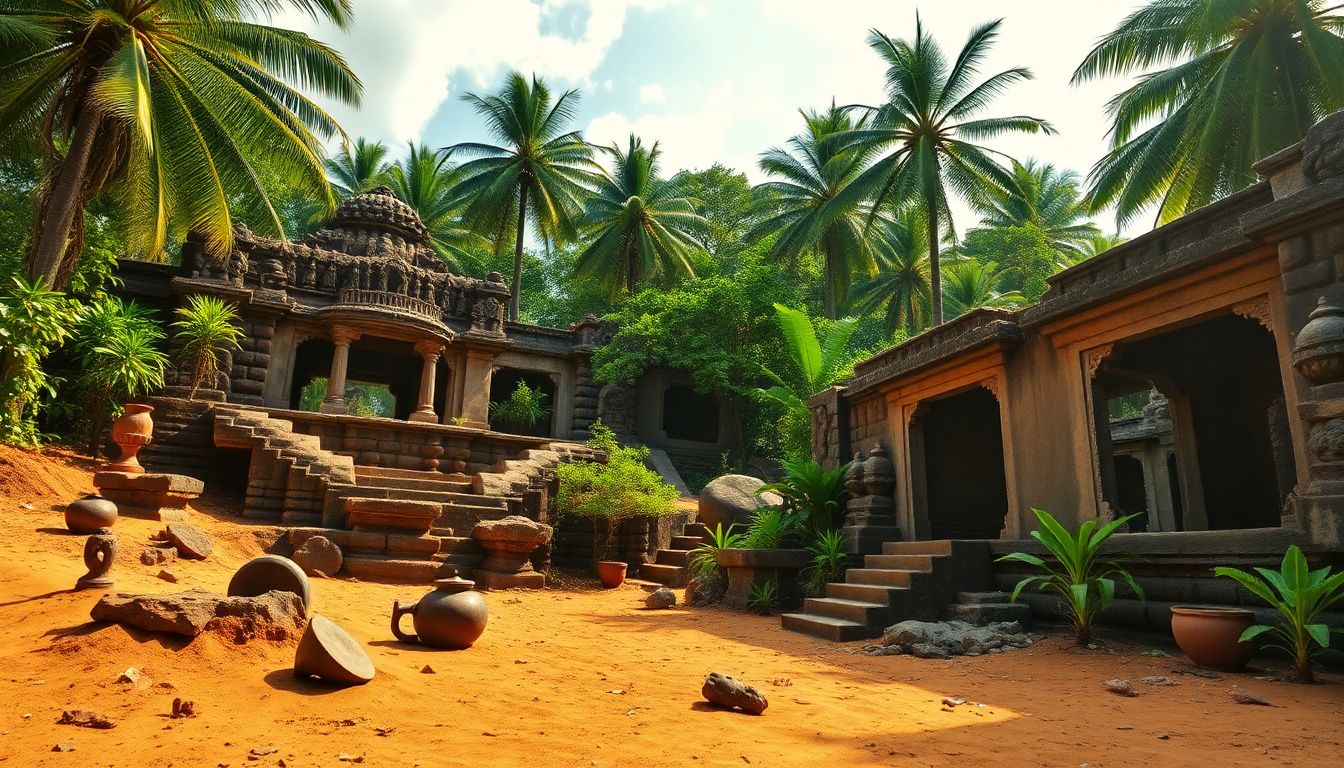Archaeological Sites in Kerala: Unearthing the Past

Archaeological Sites in Kerala: Unearthing the Past
Beyond its serene beaches and lush backwaters, Kerala hides secrets of bygone eras. Have you ever wondered what lies beneath the surface of this beautiful land? Archaeology offers a way to explore Kerala's past. It unearths stories etched in stone and buried in soil. This article explores the amazing archaeological sites in Kerala. Discoveries made give us a glimpse into the state's rich history.
Muziris: Tracing a Lost Port City
Muziris was once a bustling port. It was a major trading hub on the ancient spice route. This legendary city mysteriously disappeared centuries ago. Today, archaeological digs are bringing Muziris back to life. These digs are revealing its historical significance piece by piece.
The Muziris Excavation Project: Unveiling Ancient Trade Routes
The Muziris Excavation Project is an ongoing effort. Its aim is to uncover the secrets of this lost city. Archaeologists are working hard and have already made incredible discoveries. They have found coins, pottery, and other artifacts. These items point to trade links with Rome, Greece, and the Middle East. International researchers are also collaborating on this project. They bring their expertise to help understand the past. The finds highlight the types of goods traded. They also reveal the cultural exchange that occurred.
Pattanam: Evidence of Roman Contact
Pattanam is believed to be part of the larger Muziris urban settlement. Excavations here have unearthed strong evidence of Indo-Roman trade. Amphorae (wine containers) and Roman coins have been found. These discoveries suggest a thriving relationship between India and Rome. Pattanam offers valuable insights. It shows how Kerala was connected to the world.
Kodungallur: The Legendary Port City
Kodungallur is closely linked to the story of Muziris. Many believe it was the location of the ancient port city. It played a key role in Kerala's maritime history under the Chera dynasty. Kodungallur was a gateway. It connected Kerala to various parts of the world.
Megalithic Sites: Echoes of Ancient Rituals
Megaliths are ancient stone structures. These were built thousands of years ago. Kerala is home to numerous megalithic sites. These sites offer a glimpse into the rituals and beliefs of prehistoric people. They include:
- Dolmens
- Burial chambers
- Menhirs
Machad:The Enigmatic Umbrella Stones
Machad is known for its unique umbrella stones. These are called Kudaikkallu in Malayalam. These formations resemble giant mushrooms made of stone. The purpose of these structures is still a mystery. Some believe they were burial markers. Others think they had religious significance.
Ariyannur: Dolmens and Burial Chambers
Ariyannur is home to dolmens and burial chambers. These structures provide insights into ancient funerary practices. Archaeologists have studied these sites. They have learned about the rituals. The beliefs surrounding death in ancient Kerala.
Porkalam: Laterite Cave Burials
Porkalam features laterite cave burials. These caves were carved into the region's red laterite soil. They served as burial sites for ancient communities. Findings from Porkalam help us understand burial customs. It helps in ancient social structures too.
Forts and Palaces: Testaments to Kerala's Dynasties
Kerala's forts and palaces stand as testaments. These are from powerful dynasties that ruled the region. These structures are archaeological sites. These sites reveal Kerala's dynastic history. It showcases its architectural heritage.
Bekal Fort: A Coastal Stronghold
Bekal Fort is a massive structure on Kerala's coastline. It has a rich history and strategic importance. The fort has witnessed many battles. It has been under the control of various rulers. Its architecture reflects different influences.
Mattancherry Palace: A Blend of Cultures
Mattancherry Palace, also known as the Dutch Palace. It showcases a unique blend of Indian and European architectural styles. The palace is famous for its murals. These murals depict scenes from Hindu mythology. The palace reflects the cultural exchange. This took place between Kerala and foreign powers.
Padmanabhapuram Palace: A Glimpse into Travancore Royalty
Padmanabhapuram Palace was the former seat of the Travancore rulers. The palace offers a glimpse into their lives. Its architecture is stunning. The artifacts provide insights. These insights are of the Travancore dynasty.
Edakkal Caves: Prehistoric Rock Art and Inscriptions
The Edakkal Caves are located in the Wayanad district. These caves are significant for their prehistoric rock art. It's also important for inscriptions. These caves provide clues about early human civilization.
The Petroglyphs: Deciphering Ancient Symbols
The caves are filled with petroglyphs. These are carvings on the rock surface. These carvings depict human figures, animals, and symbols. The meanings of these symbols are still debated. Some believe they represent early forms of communication.
The Inscriptions: Tracing Ancient Scripts
The Edakkal Caves also contain ancient inscriptions. These are in different scripts. Scholars are working to decipher them. They want to unlock their historical significance.
Conservation Efforts: Protecting the Edakkal Heritage
The Edakkal Caves face many challenges. These challenges threaten their preservation. These challenges include:
- Vandalism
- Natural weathering
Conservation efforts are underway. These efforts aim to protect this valuable heritage site.
Exploring Further: Kerala's Undiscovered Archaeological Potential
Kerala holds immense potential for archaeological discoveries. Much of its past remains hidden beneath the surface. Continued research is essential.
Potential Sites and Future Excavations
Many sites in Kerala warrant further investigation. These sites include:
- Ancient mounds
- Burial grounds
- Ruined temples
Future excavations at these locations could reveal new insights. It can help us understand Kerala's history.
The Role of Archaeology in Tourism and Education
Archaeological sites can boost tourism. It can enhance education. They offer a unique way to learn. A way to appreciate Kerala's rich past. Museums also play a vital role. They display artifacts and provide information. It makes history accessible to the public.




Comments
Post a Comment